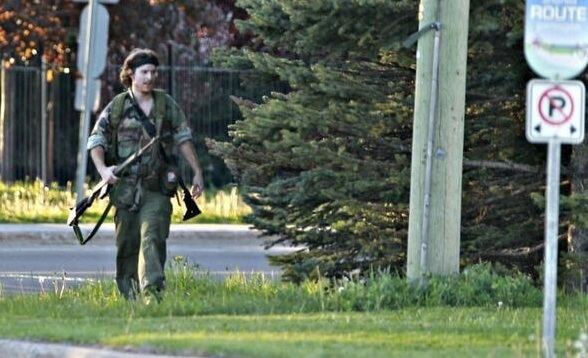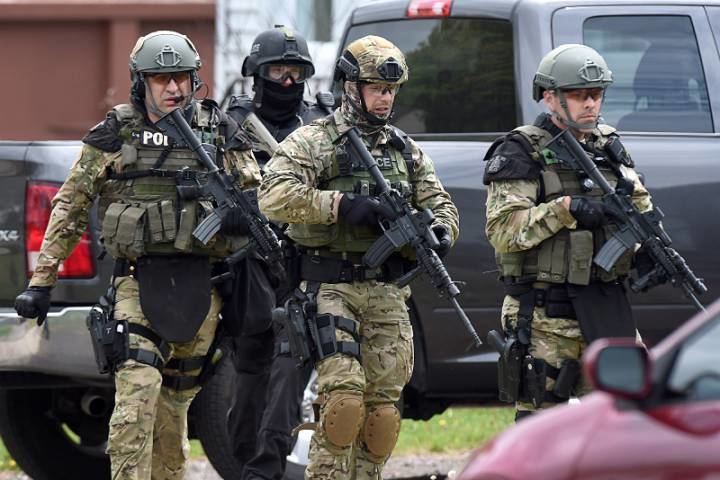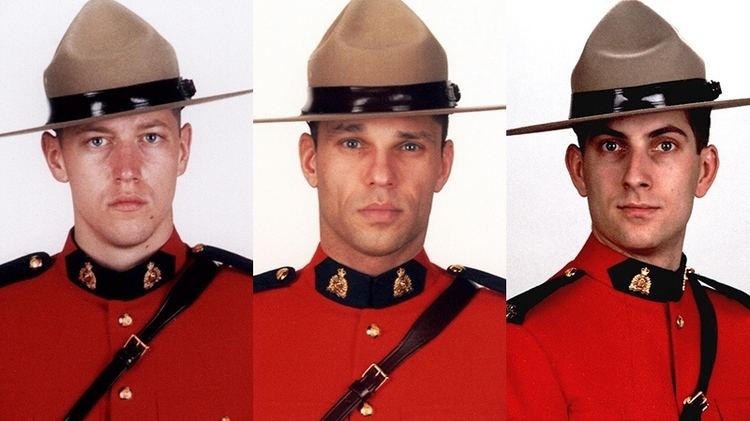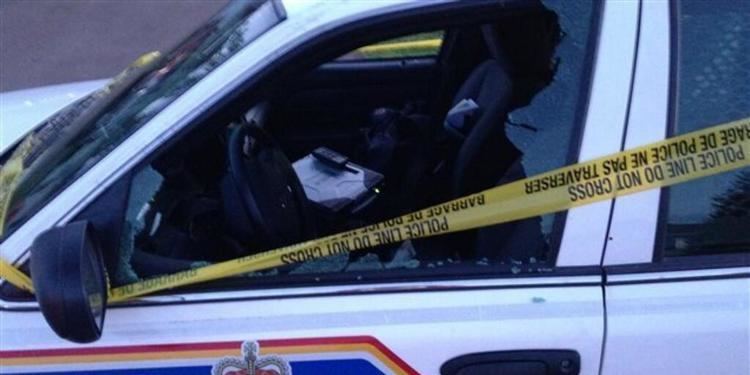Non-fatal injuries 2 Date 4 June 2014 Number of deaths 3 Location Moncton | Perpetrator Justin Bourque Location Moncton, Canada Attack type Shooting | |
 | ||
Weapons M14 rifle (.308 Winchester), Mossberg 500, Knife Similar 2014 shootings at Parlia, 2014 Saint‑Jean‑sur‑Richelieu ramming, École Polytechnique massacre, 2014 Isla Vista massacre | ||
The 2014 Moncton shootings were a string of shootings that took place on June 4, 2014, in Moncton, in the Canadian province of New Brunswick. Justin Bourque, a 24-year-old from Moncton, shot five officers from the Royal Canadian Mounted Police (RCMP), killing three and severely injuring two. A manhunt for Bourque was launched and continued overnight and into June 5. On June 6, Bourque was found and taken into custody, ending a manhunt that lasted over 28 hours. The shooting was the deadliest attack on the RCMP since the Mayerthorpe tragedy in 2005 that left four RCMP officers dead, and also Moncton's first homicide since 2010.
Contents
- Shootings
- Manhunt
- Victims
- Perpetrator
- Life prior to shooting
- Behavioural problems
- Online posts
- Legal proceedings
- RCMP and Canadian government
- Gun control
- Memorial services
- References

Shootings

At around 6:00 p.m. on June 4, 2014, Bourque purchased three boxes of ammunition in the presence of a friend, whose name has limited legal usage, and cannot be named, who did not find it unusual since the two of them planned to go to a shooting range. During the late hours of that same day, Bourque left his rented home, dressed in camouflage and carrying a rifle and a shotgun. He calmly walked down a road in his trailer park, passing several neighbours along the way.

At 7:18 p.m. ADT, the first 9-1-1 call was made to police about an armed man walking down a sidewalk on Pioneer Avenue and towards the woods west of the street. Twelve RCMP officers responded to the scene and set up a perimeter around the woods and the surrounding neighbourhood. Bourque was first seen by Cst. Mathieu Daigle stepping out of the forest, crossing a street, and entering another wooded area that bordered the backyards of several houses. Daigle sent out a radio transmission describing Bourque, but some radio static was heard, which made the description difficult to understand. Daigle was then joined by Csts. Fabrice Gevaudan and Rob Nickerson as they trailed Bourque, who was headed toward a house on Bromfield Court, where five other officers were positioned. All of the officers were intending on maintaining visual contact on him while waiting for the arrival of Police Dog Services, who were scheduled to arrive in a few minutes.

Bourque first opened fire at 7:46 p.m. after heading towards a backyard, during which he allegedly heard one of the officers shouting, "Hey!" He fired three shots at Gevaudan, all of which missed. Gevaudan fled and radioed the officers that he was being shot at, before being hit twice in the torso from about 30 meters away. He died almost instantly. His body was found a few minutes later and dragged into a nearby ditch by other officers, where CPR was attempted.

Bourque then fled the woods and emerged southeast of McCoy Street, where he continued walking in a straight line on Mailhot Avenue. There, two minutes after he shot Gevaudan, he encountered Cst. David Ross, who was driving a police sports utility vehicle down the road. Ross drew his service pistol and accelerated his vehicle towards Bourque as he was turning to face his direction. Ross fired two shots at Bourque through his windshield, while Bourque fired six shots back at him. Ross was shot twice in the hand and left shoulder, with a third fatal shot being directed at the head. It was believed he was attempting to hit Bourque with his vehicle. Cst. Eric White later found Ross's body still slumped inside the driver's seat before being forced to take cover behind the vehicle after spotting Bourque taking aim at him from further down the street.

At 7:54 p.m., Cst. Martine Benoit arrived at the intersection of Hildegard Drive and Mailhot Avenue, being guided there by a civilian who was following Bourque and reporting where he was headed via 9-1-1 call. Bourque, taking cover in a deeply shaded and wooded ditch, opened fire on her and disabled her police vehicle with gunfire, preventing her from escaping. Cst. Éric Stéphane J. Dubois responded to assist her and was wounded by gunfire while trying to give Benoit additional cover. Bourque then crossed Hildegard Drive and left, allowing Dubois to flee to the local fire station nearby. Benoit, unaware that she was safe, remained inside her vehicle for a period of time and had to be picked up by another officer.
At 7:59 p.m., seconds after the Hildegard shooting, Cst. Darlene Goguen responded to the fire station in her police vehicle, whereupon she was fired at while still seated inside and hit twice. Goguen was able to flee from the immediate vicinity with the help of Cst. Donnie Robertson. Both Dubois and Goguen survived their gunshot wounds. At this point, communications became confusing and chaotic, with the details of casualties, shooting locations, and Bourque's location varying.
At 8:04 p.m., Cst. Douglas Larche, who was plain-clothed but also wearing body armour, and armed with a shotgun, responded at Mailhot Avenue. There, he was spotted by Bourque, who then concealed himself behind several trees and fired four shots at him, wounding him. Larche returned fire with seven shots from his service pistol. Nearby residents tried to warn him about Bourque, but he was fatally shot in the neck as he tried to take cover behind his car. The entire exchange of gunfire lasted for 70 seconds. Bourque then fled the scene at 8:13 p.m. and escaped into the woods behind Isington Avenue. He had been last sighted near Ryan Street and Wheeler Boulevard.
Late on June 4, it was reported that three RCMP officers were killed, while two other officers were hospitalized with non-life-threatening injuries. According to witnesses, Bourque spotted and even spoke to several civilians while lying in wait, and left without shooting at them. Other witnesses reported that he actually waved away civilians when they tried helping the officers. The New York Times reported that television footage showed "several cars and police vehicles with bullet holes and shattered windows". The Northwest area of Moncton was locked down while the search for the shooter was in progress; public buses were pulled from the streets, and all entrances to the locked-down area were sealed.
Manhunt
Authorities named Bourque as the suspect after his family and friends saw photos of him during the shootings on Hildegard Drive circulating on news reports and social media. Multiple sightings of the suspect, by police and the public, continued in the second day of the manhunt. Up to 300 police personnel were involved in the search. Because Bourque's location was unknown at the time and he was heavily armed, a definitive perimeter and containment protocol was not established and all of the officers' activities were considered high-risk.
Pedestrians and motorists were asked to stay away from the area of the search; public transit was suspended; and schools, government offices, stores, and businesses were closed. Residents were later instructed to lock their doors, leave their exterior lights on, and refrain from broadcasting police movements on social media sites.
The next day, police surrounded an apartment building and were broadcasting a demand to exit over a public address system. More than a dozen armed officers surrounded the building and deployed a robot with a camera inside at approximately 3:00 p.m. Minutes later, they left the apartment complex after finding no sign of Bourque. The report that called police over to the building later turned out to be a false alarm. A police helicopter with thermal-imaging cameras was searching Moncton. At least two armoured cars were borrowed by the mounted police to transport heavily armed tactical team members.
On June 6, at 12:10 a.m. (Atlantic Daylight Time), Bourque was arrested by the RCMP with the help of a Transport Canada surveillance aircraft, after a resident saw him crouched below a window in a yard on Mecca Drive and called police. The lock-down, in effect for approximately 28 hours in the North End of Moncton, was lifted shortly thereafter. While being taken into custody, he reportedly told police, "I'm done." He was unarmed at the time of his arrest, but several weapons were found at the scene. On June 7, a search was launched at a field and a wooded area located near the scene of Bourque's arrest.
Victims
Three RCMP officers were killed in the shootings and another two injured. All five shooting victims were identified by police two days after the shootings. The fatalities were identified as Cst. David Ross, 32, of Victoriaville, Quebec; Cst. Fabrice Georges Gevaudan, 45, of Boulogne-Billancourt, France; and Cst. Douglas James Larche, 40, of Saint John, New Brunswick. The two surviving officers were identified as Cst. Éric Stéphane J. Dubois and Cst. Marie Darlene Goguen. On August 11, the causes of death were released in an agreed statement of facts filed by the Moncton Queen's Bench. David Ross died from a gunshot wound to the head, Fabrice Georges Gevaudan died of two gunshot wounds to the chest, and Douglas James Larche died after being shot in the head and left flank.
Perpetrator
Justin Christian Bourque (born November 12, 1989), a resident of Moncton, was named by authorities as a suspect in the shootings. He was 24 years old at the time. He explained in a police interview following his arrest that his actions were a rebellion of sorts against the Canadian government, which he believed to be oppressive. He stated that he believed that police officers were protecting such a government. During the shooting incident, Bourque was dressed in military camouflage and wore a green headband.
Life prior to shooting
Bourque was born as one of seven children in a religious family and was home-schooled. Eighteen months prior to the shooting, he moved out of his parents' home and into a trailer park in Moncton's Ryder Park neighbourhood. He had been forced to move out on his parents' request following a dispute over his purchase of a second firearm and his "inappropriate behaviour". He had recently quit his job working at a local grocery store and had just been hired by the distribution warehouse Rolly's Wholesale Ltd., according to a company official.
Behavioural problems
A former coworker said that "he's always seemed to have a problem with authority. Issues with parents, bosses, police..." He also reportedly held anti-government and anti-authority views, had a fascination with conspiracy theories, and talked about killing other people and himself. Two days before the shooting, Bourque made rants against all figures of authority to his father, during which he was described as becoming "paranoid".
The day after the shooting, a local firearm and outdoor supply store, Worlds End Warehouse, issued a statement on their Facebook page, confirming that Bourque was known personally by employees of the store but that he "was never a customer and never purchased firearms or ammunition from [them]".
One of Bourque's friends described an incident where Bourque had gone camping with several colleagues and brought "his rifle with him, without ammunition, which he held onto the whole night while drinking. That kind of freaked us out, so we didn't invite him the next time". It remains unclear if anyone had previously reported safety concerns related to Bourque's firearm possession but local police stated that he "was not known to them". In Canada, individuals who are concerned about the mental state or intentions of a firearms owner can notify the Canadian Firearms Program so that police can investigate.
Following his arrest, Bourque claimed that he originally planned to harm the oil industry by setting fire to several Moncton gas stations and then shoot random people, but abandoned the plan due to issues with his bicycle. He purchased the .308 Norinco M305 used in the shootings on July 24, 2009, and had a valid firearms certificate for the rifle.
Online posts
The media reported that Bourque's Facebook account was filled with images and "occasionally jokey posts about the right to bear arms". The media has reported that his social media contains anti-police posts as well. A post added to his Facebook page the day of the shooting contains a photo with a quote from Dave Chappelle, "You ever notice a cop will pull you over for a light out, but if your car is broke down they drive right past you?". He also tended to share images with slogans such as "Free Men Do Not Ask Permission to Bear Arms" and "Militia Is Only a Bad Word if You're a Tyrant".
In his Facebook page, he also posted his beliefs that Canada was "too soft" to survive an impending attack, once writing in response to the 86th Academy Awards:
The third world war could be right around the corner, wishful thinking isn't gonna stop this one. This will not be like Iraq, NATO is vastly outnumbered by Russia and her allies.
Three weeks after that post, he also warned that: "Canada is one of the world's most likely targets Russia would invade at the start of a war due to pushover resistance." A few hours prior to the shooting, Bourque posted lyrics from "Hook in Mouth", a song by American thrash metal band Megadeth.
Legal proceedings
After his arrest, Bourque admitted responsibility to the shootings and claimed that he committed them in an attempt to spark a rebellion against the Canadian government, which he believed was oppressive, corrupt, and serving only the wealthy at the expense of other citizens.
Soon after his arrest, Bourque made his first court appearance at a Moncton courthouse under heavy guard. He was charged with three counts of first-degree murder and two counts of attempted murder. On July 3, Bourque briefly reappeared in a Moncton provincial court. He made his next court appearance on July 31 after undergoing a psychiatric assessment requested by his lawyer. He was found fit to stand trial.
On August 8, Bourque entered guilty pleas to the three counts of first-degree murder and also the two counts of attempted murder. On October 27, he apologized to the families of the slain RCMP officers. On October 31, he was given a life sentence without the possibility of parole for 75 years. It was considered the harshest sentence in Canada since its last executions in 1962.
RCMP and Canadian government
In the wake of the shooting, the New Brunswick Premier David Alward issued a statement, saying that he felt "incredible grief" from the killings, and offered condolences to the families of the slain officers. Assistant Commissioner Roger Brown, commanding officer of the New Brunswick RCMP, called June 4 "perhaps the darkest day in the history of RCMP New Brunswick". Moncton Mayor George LeBlanc said in a statement on Twitter, "Terrible sad news for Moncton. Stay indoors and allow police to do their job. Prayers for the families." The House of Commons observed a moment of silence prior to question period the day after the initial shooting.
Canadian Prime Minister Stephen Harper also issued a statement, saying, "On behalf of all Canadians, Laureen and I offer our deepest condolences to the families, colleagues and friends of those affected by this tragedy. We also offer our prayers for the speedy recovery of those injured." He also remarked that this incident reminds us that "men and women in law enforcement put their lives on the line in Canada every day to protect our citizens and communities". RCMP Commissioner Bob Paulson released a statement regarding the three slain officers, saying, "Their deaths are beyond comprehension. Their ultimate sacrifices will never be forgotten."
An internal review was announced by the RCMP on June 9 to investigate whether the five officers shot were adequately armed and protected to deal with Bourque, who was armed with high-powered firearms, and how to prevent a similar incident from occurring. The review was later ordered on July 3. However, the decision for an internal review was criticized, with many calling for an independent inquiry. Among the critics was Darryl Davies, a criminologist from Carleton University, who had made a report for the RCMP in 2009 about the Mayerthorpe tragedy which left four RCMP officers dead; the report recommended officers be immediately given training and equipped with high-powered firearms. Davies alleged that his report was ignored by the RCMP and believes that an internal review will not result in long-term changes, saying, "I think an internal inquiry is not going to be transparent, number one — that's why we need a public inquiry."
On January 16, 2015, the RCMP released the MacNeil Review, an independent review that was conducted by former Assistant Commissioner Alphonse MacNeil. It included a total of 64 recommendations concerning supervision, training, technology and equipment, communications, and aftercare. The review revealed that there were complications in communication between officers during the shootings because multiple officers were sending radio transmission at once, and that none of the first responding officers were wearing their body armor. It has been publicly announced that the RCMP accepted and will implement all of the recommendations, and will also keep the public updated on their progress.
Gun control
After losing two of its members in the attack, Canadian gun rights advocacy organization the National Firearms Association released a statement following the shooting, offering their condolences and deploring the incident. They also claimed, "Incidents like these demonstrate...that none of Canada's firearms control efforts over the past 50 years have had any effect on preventing violence, or otherwise stopping bad people from carrying out their evil deeds... The excessive rules in place do not in any way increase public safety, but merely contribute to an expensive and unnecessary regime which harms only those of lawful intent." The executive director of the Canadian Sport Shooting Association felt that the NFA statement was premature and that, instead of gun control, this incident should lead to discussions about "mental health issues." The NFA stood by their statement, claiming that they were responding to the calls for tighter gun control that people on social media and in the government were making.
A gun control organization, the Coalition for Gun Control, felt the incident was too recent to begin discussing changes. At the same time, a prominent supporter of the group and practicing psychiatrist Ron Charach published an op-ed piece calling for more stringent gun control. Among other things, he called for the reclassification of semiautomatic rifles as prohibited, the restoration of the Long Gun Registry, and "[a]n absolute ban on urban gun collecting..."
Memorial services
On social media, the hashtag #PrayforMoncton began trending. In response to the shootings, the RCMP created an e-mail for the public to send in their condolences, and the RCMP Foundation set up a fund to donate money to the families of the slain and injured officers. A regimental funeral was held on June 10 at the Moncton Coliseum, with close to 3,000 police officers and many other mourners in attendance.
